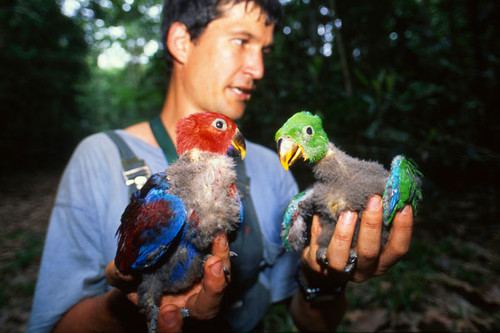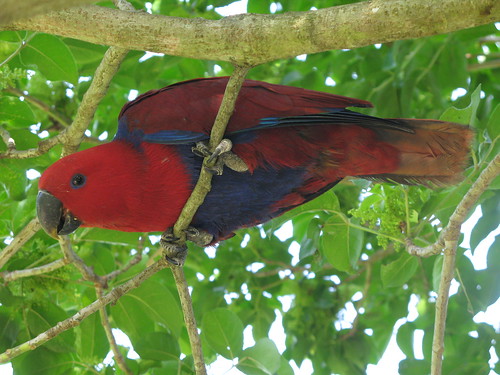 Professor Robert Heinsohn's findings on eclectus parrots underlines the importance of preserving rainforests. Photo: Robert HeinsohnThe calculated killing of male eclectus parrot chicks by their mothers has been linked to a shortage of suitable nesting hollows that don't flood during tropical storms in northern Australia.
Professor Robert Heinsohn's findings on eclectus parrots underlines the importance of preserving rainforests. Photo: Robert HeinsohnThe calculated killing of male eclectus parrot chicks by their mothers has been linked to a shortage of suitable nesting hollows that don't flood during tropical storms in northern Australia.
The rare example of sex-specific infanticide was discovered by Australian National University evolutionary biologist Professor Robert Heinsohn during a 10-year study of the colourful, cockatoo-sized parrots in remote Cape York rainforest. It has profound implications for future management of Australia's remnant rainforests to ensure genetic diversity and survival of these spectacular birds.
 Female Eclectus parrot. Image by Terry FanFemale eclectus parrots compete fiercely for nesting hollows, rarely leaving their keenly-defended nests. Professor Heinsohn found females forced to nest in poor quality tree hollows, prone to flooding during heavy rain, were killing off newly hatched male chicks because they took longer to rear.
Female Eclectus parrot. Image by Terry FanFemale eclectus parrots compete fiercely for nesting hollows, rarely leaving their keenly-defended nests. Professor Heinsohn found females forced to nest in poor quality tree hollows, prone to flooding during heavy rain, were killing off newly hatched male chicks because they took longer to rear.
''We found a number of corpses on the ground below nesting hollows. The deaths were highly suspicious, because they were all males, and the wounds suggested they'd been killed by a parrot, so something unusual was happening,'' he said.
These deaths also echoed trends observed by several zoos, where captive eclectus parrots produced long runs of chicks of the same sex.
''There were cases where birds produced up to 30 male chicks in a row, then switched to a run of females. Why would they concentrate their efforts on a particular sex? We found the answer was linked to nest quality.''
Professor Heinsohn's findings - published online this week in the science journal Current Biology - are attracting international interest. Six years ago, he solved a long-standing mystery of why these parrots have distinct gender colour differences. An eight-year study revealed females used their crimson colouring as a flag to warn a hollow was occupied. The emerald green males blend with the rainforest canopy while foraging for food to bring the nesting females.
This gender colour difference also enables females to decide the fate of chicks within hours of hatching. Female chicks fledge up to seven days earlier than males, so adult females with flood-prone nests have a better chance of reproductive success if they concentrate maternal efforts on the faster-fledging females.
''Poor quality nests will flood, drowning the chicks. So the adult females make a choice to speed up development by killing the males,'' Professor Heinsohn said.
Eclectus parrots are native to tropical Australia, New Guinea and the Solomon Islands, nesting in tree hollows about 30m above the rainforest floor and favouring black bean, tropical fig or milky pine trees.
''There's a shortage of hollows, so we do need to think about how to provide suitable nesting habitat, or we may end up with less genetic diversity and a sex-skewed population of parrots,'' he said